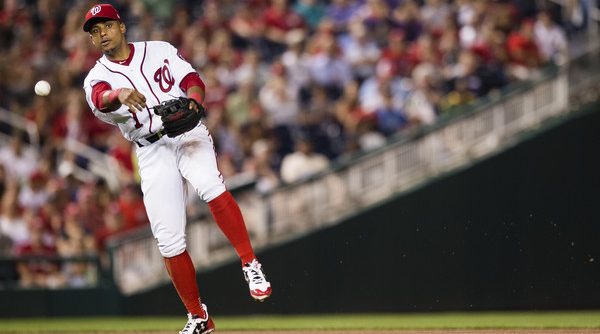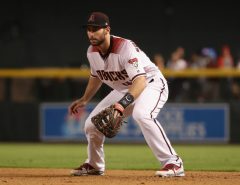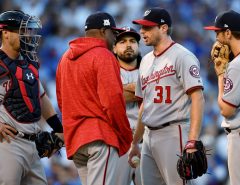On June 29th, after Trea Turner unsuccessfully tried to turn away from a 96 mph 2-1 fastball up and in from Pedro Strop of the Cubs, a lot of things happened: First, Turner walked slowly to first on a hit by pitch, the Nationals scored three runs that inning and took the lead, and the (then) horrific bullpen coughed up that lead in the top of the 9th. The other thing that happened was Turner’s right wrist was broken, sidelining him for what appears to be an approximately 8-week stint on the disabled list (Turner is currently rehabbing in AAA Syracuse).
At the time it felt like a pretty gigantic blow to the Nationals. Turner had not duplicated his remarkable 2016 rookie campaign, but had continued an upward trend to his season that was generating hope he was headed back towards those lofty performance heights. This injury, combined with the shaky health of primary back up shortstop Stephen Drew, would vault Wilmer Difo into the starting lineup on a daily basis.
This was a less than rosy proposition at the time; Difo to that point in his career 169 plate appearances had slashed a less than inspiring .229/.298/.314, totaling a 58 wRC+. That is to say Difo was 42% worse than the average major leaguer while standing in the batter’s box. For a team dealing with a plethora of injuries, having a young lynch pin who seemed to finally be getting his sophomore season moving go down — and to be replaced by someone with a big league track record like Difo’s — this must have felt like a haymaker instead of another body blow.
Then something remarkable happened: Wilmer Difo played great baseball. The real question was — as the end of August approaches and Turner begins his path back towards the Nationals shortstop position — just how great has Difo been in Turner’s absence? At first it felt right to compare Difo to how Turner played in his so far shortened 2017, but that was too easy, so maybe comparing him to Turner’s no-one-can-doubt-how-amazing-it-was 2016 rookie campaign would be more instructive?
So let’s turn back the clock and review Turner’s 2016 assault on the majors: In 324 plate appearances in the (mostly) second half of the season, Turner displayed a gaudy .342/.370/.567 slash line en route to a 147 wRC+. FanGraphs had Turner with fantastic offense and baserunning, but with sub-par center field defense in his debut campaign, and Turner finished second to Corey Seager in N.L. Rookie of the Year voting despite recording significantly less playing time.
Then we review Difo’s efforts since July 2nd (his first start at SS after the Turner injury): In 152 plate appearances Difo has slashed .341/.403/.470 to the tune of a 123 wRC+. Over those two months he has been good in all three aspects of the game, showing a better glove than many thought he would have at short.
How does this compare to Turner’s rookie output? In an effort to compare them on an apples to apples basis, a WAR per plate appearance formula was landed on because… stuff? There wasn’t a lot of planning, it just seemed like a solid way to compare two different sized periods of playing time by two different players. So Turner’s 3.3 WAR in 324 plates appearances led to a .0102 WAR/PA in 2016. Since July 2nd, Difo has amassed 1.6 WAR in 152 plate appearances, which gives him… oh my… .0105 WAR/PA. To put it another way, when looking at their total games — not just their offense — Wilmer Difo in Trea Turner’s absence has been about 3% better than 2016 Trea Turner. You know, that “he was so good lots of people were calling him baseball’s next superstar” 2016 Trea Turner.
The burning question is: Is this the real Wilmer Difo? The answer: Probably not. If you look no further than Difo’s .416 BABIP over this time frame, it is pretty clear there has been some offensive luck in Difo’s favor, but the fact that he has been a positive in hitting, defense, and baserunning over this span in his first regular playing time as a major leaguer is an incredibly positive sign for a guy that could be be in line to replace Daniel Murphy at second base after the 2018 season. The new burning question is: How can the Nationals afford to sit a player going like Difo is after Turner and Jayson Werth return from the DL in the coming days? Well, maybe you’ll just have to tune in to the next article to figure that one out… no, no you won’t. The obvious answer is sit Werth until Difo cools off. Dusty Baker won’t let that happen, but if you had the option in September 2016 to sit Jayson Werth so Trea Turner could play, would you? Exactly.
Tags: Nationals, Nats, Trea Turner, Washington Nationals, Wilmer Difo




I think the answer might be to put Murphy on the DL, since he’s obviously not healthy, and slide Difo over to 2B. Once Murphy comes back, mix Difo in at both SS and 2B so that both Turner and Murphy are fresh for the playoffs.